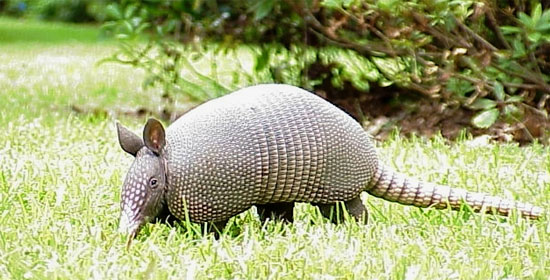Weekend Gardening: Outwit and Outlast Those Troublesome Armadillos
May 28, 2011
 Have you ever discovered your once beautiful green lawn looking like the surface of the moon, full of craters? If so, then you may have been visited by an alien-looking creature known as the armadillo.
Have you ever discovered your once beautiful green lawn looking like the surface of the moon, full of craters? If so, then you may have been visited by an alien-looking creature known as the armadillo.
Armadillos originated in South America. They are mammals. They are neither rodents nor marsupials and are not related to the opossum. Their closest living relative is the anteater and sloth.
The most easily recognized feature of an armadillo is its shell. Their common name, armadillo, is derived from a Spanish term meaning “little armored one”. All armadillos have shells, made of true bone, that cover their backs. Most armadillos also have bony rings or plates that protect their tails.
Digging machines
Armadillos are built to dig. They rely on this ability to escape danger and survive. They prefer sandy or loam soils that are relatively easy to excavate. Therefore, they are well adapted to Northwest Florida soils.
Armadillos typically rest in deep burrows during the day and become more active during the late evening, night, or early morning. These burrows are usually located under brushpiles, stumps, dense brush, or concrete patios, and are about 7 to 8 inches in diameter and can be up to 15 feet long. They often have several burrows throughout their territory.
Food sources
Armadillos feed primarily on insects. They also eat earthworms, scorpions, spiders, snails, and small vertebrates and their eggs. They consume large amounts of armyworms, cockroaches, ants, wasps, flies, beetles, and grasshoppers. They have been known to dig up entire yellow-jacket nests.
Some consider the armadillo a beneficial creature because they eat potential pests. Many consider the armadillo a pest because of their destructive ways. Armadillo can burrow under driveways and patios causing structural damage. Burrows in pastures can pose a potential hazard to livestock. And because armadillos usually search for food by rooting or digging in the ground, they can damage large areas of the lawn or garden.
Control measures
If you find that you cannot live with these creatures, the University of Florida recommends four ways to deal with armadillos.
- reducing the amount of water and fertilizer you apply to your lawn
- creating barriers (e.g., fences),
- live-trapping
- shooting offending individuals (check local ordinances)
The best solution (and the most expensive) is a stout fence to keep the armadillos out. If you take this route, make sure the fence is buried at least 18 inches into the ground, or they might just burrow under it.
Reducing the water and fertilizer applications to your lawn may help reduce armadillo damage. A moist lush landscape is perfect for earthworms and insect larvae. Armadillos love earthworms. Sometimes watering adjacent areas may attract armadillos away from a site.
Trapping can be frustrating and may require some ingenious thinking. Some tried and true trapping techniques are discussed at length in an online University of Florida publication by Dr. Russ Mizell at http://ufinsect.ifas.ufl.edu/armadillo.htm.
Remember that poison baits are illegal and ineffective. No chemical repellents or fumigants are registered for use in Florida.
Armadillos are very happy in Northwest Florida and are here to stay. If they have become unwelcomed house guests, put your thinking cap on and be committed to outwitting and outlasting this prehistoric-looking creature.
For more information, contact Theresa Friday at 850-623-3868 or email tlfriday@ufl.edu. Friday is the Residential Horticulture Extension Agent for Santa Rosa County.
Courtesy photos for NorthEscambia.com, click to enlarge.
Comments
12 Responses to “Weekend Gardening: Outwit and Outlast Those Troublesome Armadillos”





I can understand everyone’s frustration, if only they were not such peaceful little creatures, its hard to kill the gentle, if only they were mean. This dilemma is a two lane blacktop., for me anyway.
You know, I would leave them in peace if they would me.. It’s bad when you sweat
your butt off trying to have a decent lawn and flower garden,just to have these
bas@#&ds destroy it by the time you wake up the next morning!!! I’ll give “em
peace,, they can rest in peace after I shoot them !!!!
I found another method for trapping them is to dig a hole, set a metal bucket down inside it and balance a plank over the hole in such a way that the weight of the armadillo will cause the plank to drop it into the bucket when the critter walks out on the plank. The plank should be lightly dusted with soil, and perhaps seeded with meal worms or such. Of course, you have to make sure the hole and the bucket are big enough to contain it. Then use your discretion on how to extract, relocate, or dispose of it.
I remember when my son was young and we used to think they were cute!!!!
Leon: do we use our brains when a fox is in the chicken house or perhaps coyotes killing our livestock or even when bugs and insects attack our garden. At some point and time nuissance critters that destoy what we work for must go. Using a gun at times may mean we are using our brains!!
Why did the ckicken cross the road?
To show the armadillo it can be done!!
22 shorts, and the flashlight has worked the best for me.
I have a 100 pound American Bulldog that has made it his mission in life to rid the world of armadillos. I must say they’re beginning to thin out where I live.
Oops! Should read it again – not the size of the Armidillos, it’s the size of the burrows.
im POSITIVE that if i encountered an armadillo “7-8 inches in diameter and 15 feet long”, id be taking a video for YOUTUBE! and, then….call 911 !! (im sure that had to be a typo, hopefully!)
Leave those animals in peace….what about if we start shooting everything we do not like ….lets use our brains.not our guns.
The 12 guage and a flashlight methed seems to be a pretty effective control measure.
Blast ‘em I say!
“Using genetic sequencing machines, researchers were able to confirm that about a third of the leprosy cases that arise each year in the United States almost certainly result from contact with infected armadillos. The cases are concentrated in Louisiana and Texas, where some people hunt, skin and eat armadillos.”
http://www.nytimes.com/2011/04/28/health/28leprosy.html